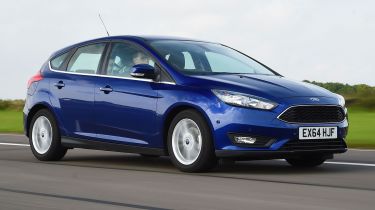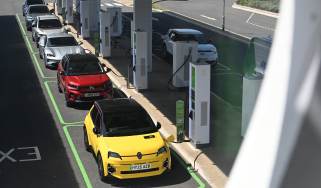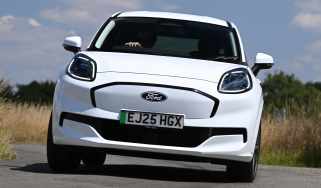New Ford Focus 2014 review
Refreshed Ford Focus hatchback is now more refined, and a serious rival to class leaders

Ford has injected more class into the Focus, better equipping it for a family hatchback market which demands ever more luxury and technology. Thankfully, it’s kept the car’s unique selling point, its handling, intact. The Golf may be a superior all-rounder, but the Focus is more fun and better value.
When one of Britain’s best-selling cars gets a refresh, it’s big news – especially when it’s an update as extensive as the one applied to the Ford Focus. There’s good reason for the changes, too, with the SEAT Leon, VW Golf and Skoda Octavia now ahead of it in the family hatch class. So is this update enough to propel the Focus to the top spot?
We all know how important first impressions are, and the Focus now makes a better one than before. The awkward rear lights and the gaping front inlets have been replaced with a design that’s more harmonious.
The idea here was to give the Focus more of a premium look and the slender front lights, chrome-slatted grille and smaller tail-lamps all help. And it’s reinforced further once you climb into the Focus’ refreshed interior – perhaps the most welcome change of all. Each model – with the exception of entry-level Studio cars – comes with an eight-inch colour touchscreen, which includes many of the functions that were controlled by a confusing array of buttons in the old car.
Used - available now

2021 Ford
Focus
39,965 milesManualPetrol1.0L
Cash £14,000
2023 Ford
Focus
23,011 milesManualPetrol1.0L
Cash £14,837
2020 Ford
Focus
35,039 milesManualPetrol1.5L
Cash £11,199
2021 Ford
Focus
30,428 milesManualPetrol1.0L
Cash £13,060As a result, it feels much more usable, hi-tech and, crucially, better suited to battle the luxurious Golf – although it’s still not quite as plush. Elsewhere, there’s a new steering wheel design, with better controls for the infotainment system.
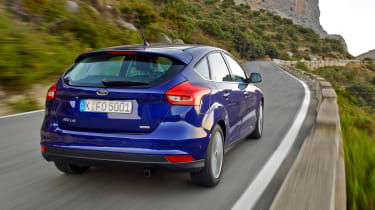
The engine highlights are geared towards efficiency, with a new 1.5-litre EcoBoost, which replaces the 1.6 EcoBoost, a new 1.5 TDCi (to be sold alongside the 1.6 TDCi – but with only £100 between them, why bother?) and a more efficient 1.0-litre EcoBoost that stretches down to a 99g/km version.
We tried the 1.5-litre EcoBoost, with 180bhp, which is exactly the same output as you got in the more powerful version of the old 1.6 EcoBoost. Fuel economy is up from 47.9mpg to 51.4mpg, though, and Ford says that the power is delivered lower down in the rev range. As a result, on our test drive we noticed it felt more responsive and more flexible, but probably only because we had an old 1.6 EcoBoost standing by as a reference point.
Other enhancements under the skin include improved sound insulation to the extent that Ford now says the Focus is the class leader in this area. It’s mainly down to extra insulation in the windows, improved door seals and extra sound deadening in the wheel wells.
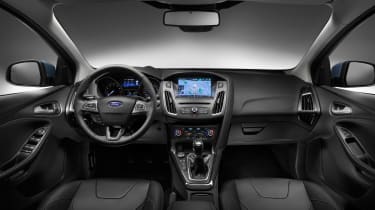
With the smooth petrol on board, there’s barely any engine noise in the cabin and the amount of tyre and wind noise is definitely reduced over the outgoing car. So is it better than the VW? Usefully, there was a 1.4 TSI Golf on hand to compare, and the differences between the two are so minor you’ll struggle to decide which is better for a long journey.
The Focus has always led the way for handling, but Ford hasn’t rested on its laurels here, either. It has made tweaks to the steering so that it feels more responsive just off centre, but without making it feel twitchy at speed.
Turn-in is slightly crisper than it was before, really helping you to make the most of the Focus’ excellent chassis. It has a litheness and an adjustability to it that the Golf doesn’t quite offer. And Ford has also done its part to improve comfort by tweaking the suspension. Over bumps and ruts, it provides a cushioned ride, ensuring the Focus still works as a relaxing family car.
Despite the updates and the boost in luxury, Ford has retained the same £13,995 starting price tag as before, while our top-spec Titanium X car costs £100 less than the outgoing equivalent.
With the Focus’ new design and better cabin, the family hatchback class is more closely contested than ever. For driving fun, the Focus wins out, but for luxury, the Golf still just edges it.
